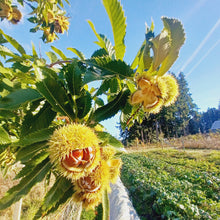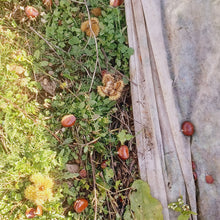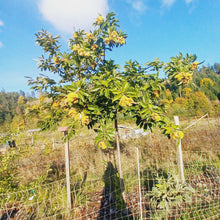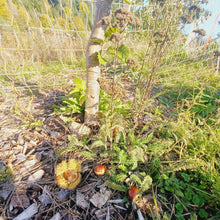| Selected for: | precocity (early bearing), nut size |
|
Mature height x width: |
approx 30' x 30' |
|
Recommended initial spacing: |
5-10' in rows 15-30' apart |
|
Recommended final spacing: |
approx 30' apart |
| Hardy to: | approx -20 to -25°C (-10 to -5°F) |
|
Preferred soil: |
well-drained, slightly acidic, sandy loam |
|
Good for: |
marginal or fertile land, productive / low-maintenance crop |
|
Uses: |
grain substitute, desserts, main dishes |
Chestnuts were once a crucial staple crop in many parts of North America, Europe, and Asia, and they are enjoying a resurgence. Nuts can be roasted, boiled, or dried and milled into a flour. Chestnut trees are low-maintenance, productive, and tolerant of drought and sandy/rocky soils. Spiky shells deter squirrels from getting to nuts before you do.
Genetics: These chestnuts are grown from seed collected in our young European x Japanese orchard block from trees that started producing nuts by four years of age. The offspring of these trees have an increased chance of producing nuts at a young age (precocity), especially if given ideal growing conditions with plenty of sun, water, drainage and fertility)
Planting: Chestnuts prefer well-drained, slightly acidic, sandy loam soil. They are intolerant of clay or wet soils. They are wind-pollinated so they require at least two to make nuts. Planting several in the same area helps to ensure adequate pollination. Requires watering for the first few years while they're getting established. Best planted when dormant (Nov-Mar) but can be planted later in spring.
Why seedlings? Growing seedlings from high-quality parents helps maintain diversity (each seed is a new variety) while drawing on some of the best genetics for chestnuts in our bioregion. In other words, you are breeding new, regionally-adapted chestnut varieties! Some trees may be poor producers or produce low quality nuts, so we recommend planting several of these trees closer together and selecting your final tree once they've produced their first nuts (3-5 years). Recommended final spacing is ~25' between the centre of each tree.
Why bare root? "Bare root" means that the tree has been grown in the ground (rather than in a pot). In general, bare root trees tend to have larger root systems because their roots aren't constricted by the edges of the pot. Because we don't need to use pots or potting soil, we can sell them more cheaply than potted trees. Bareroot trees must be planted when they are still dormant (Nov - Mar in our region).







